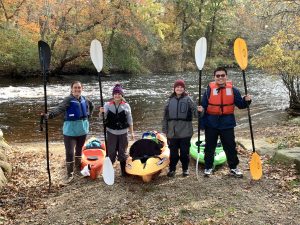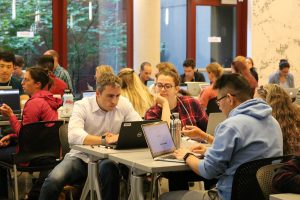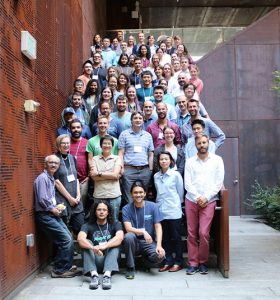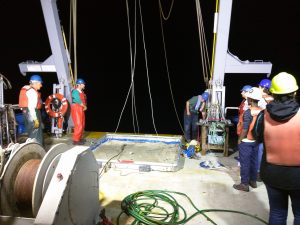MARN 4001 students Sarina Dery and Mackenzie Blanusa paddle down the Pawcatuck River with research assistant Lija Treibegs and TA Mengyang Zhou in order to collect water samples to identify dominant nutrient sources from the watershed.
Uncategorized
Researchers from Marine Sciences at the 14th ICMGP in Krakow, Poland
The bi-annual week-long conference, International Conference on Mercury as a Global Pollutant (ICMGP) was held in Krakow in Poland in September. During this conference academic researchers, consultants, policy makers and companies that specialize in mercury analytical instrumentation showcased recent developments in their specific areas. Graduate and undergraduate students and faculty from the Department of Marine Sciences (listed below) presented their findings on mercury in atmosphere and marine environment and enlarged their professional networks. The Distinguished Professor (emeritus) William Fitzgerald, who has pioneered the field of Marine Mercury in the Department of Marine Sciences here at UConn, was also among the attendees (seen on one of the photographs with his former student and current UConn faculty, Prof. Robert Mason).
Dr. Robert Mason, Professor
Dr. Zofia Baumann, Assistant Research Professor
Mackenzie Blanusa, Undergraduate
Gunnar Hansen, Ph.D student
Yipeng He, Ph.D student
Wesley Huffman, Ph.D student
Patricia Myer, Ph.D student
Zooplankton vulnerability to Warming: Go with the Flow, But It Is Complicated
Work from Professor Hans Dam’s laboratory (https://marinesciences.uconn.edu/faculty/dam/) led by Ph.D. student, Matthew Sasaki (https://marinesciences.uconn.edu/students/sasaki/) shows that zooplankton vulnerability to warming depends on a complex interplay of population dispersion, local adaptation, and phenotypic plasticity. Thus predicting the fate of the oceanic biota to climate change is a multifaceted issue that requires careful integration of oceanography, ecology, and evolution.
The work (https://onlinelibrary.wiley.com/doi/abs/10.1111/gcb.14811) is published in the prestigious journal Global Change Biology, and is also highlighted in a lay-audience article (https://today.uconn.edu/2019/09/ocean-dweller-ability-respond-warming-waters-location/?utm_source=listserv&utm_medium=email&utm_campaign=daily&utm_content=uconn-today) in the online Magazine, UConn Today.
DMS graduate student participates in Oceanhackweek 2019
For the first week of the semester, PhD student Molly James participated in the second annual Oceanhackweek, hosted by the eScience Institute at University of Washington in Seattle, WA. Oceanhackweek brings together a diverse group of people at all career stages and at every level of coding experience. The organizers state it best: “In contrast to conventional academic conferences or workshops, hackweeks are intensive and interactive, facilitated by three core components: tutorials on state-of-the-art methodologies, peer-learning, and on-site project work in a collaborative environment.”
Molly learned about and completed tutorials on data science tools in the oceanographic community. The topics of the tutorials included Github, cloud computing, Jupyter notebooks, python visualization tools, machine learning, and other open source resources. She also organized a “hack” project that addressed the issue of co-locating data from disparate data servers, in order to either validate or supplement a data set with another. Her group decided to approach this task by looking at over 30 ERDDAP servers hosted by different organizations. The group utilized Jupyter notebooks and python packages to create a user-friendly search tool that queries these multiple servers simultaneously. Despite having less than 5 days to work together, the team produced a beta-version of the search tool by the end of Oceanhackweek. The documentation and code development is available on their team Github code repository.
Other interested scientists of all levels should keep an eye out for the application to Oceanhackweek 2020! It is a great opportunity to build community and confidence in computing skills.
Ann Bucklin presented with ICES Outstanding Achievement Award
Molecular biologist Ann Bucklin presented with Outstanding Achievement Award during the opening ceremony of ICES Annual Science Conference in Gothenburg, Sweden.
Ann Bucklin has made significant contributions to ICES over a long career marked by a continued high level of commitment to excellence in science, research, and training. For more than 20 years, Ann has been a member of ICES community and has had an ongoing impact in the field of marine science over this time.
Her contributions were recognized at the opening of ICES Annual Science Conference 2019 in Gothenburg, Sweden.
Read the complete article here: https://www.ices.dk/news-and-events/news-archive/news/Pages/An-outstanding-role-model-Ann-Bucklin-presented-with-Outstanding-Achievement-Award.aspx
Fishing changes silverside genes
Over recent decades, many commercially harvested fish have grown slower and matured earlier, which can translate into lower yields. Scientists have long suspected that rapid evolutionary change in fish caused by intense harvest pressure is the culprit.
Now, for the first time, researchers have unraveled genome-wide changes that prompted by fisheries – changes that previously had been invisible, according to a study published in Science by a team of researchers including Hannes Baumann, UConn assistant professor of Marine Sciences, who collaborated with researchers at Cornell University, the University of Oregon, the National Marine Fisheries Service, and Stanford University.
In unprecedented detail, the study shows sweeping genetic changes and how quickly those changes occur in fish populations extensively harvested by humans, says Baumann.
“Most people think of evolution as a very slow process that unfolds over millennial time scales, but evolution can, in fact, happen very quickly,” said lead author Nina Overgaard Therkildsen, Cornell assistant professor of conservation genomics in the Department of Natural Resources.
In heavily exploited fish stocks, fishing almost always targets the largest individuals. “Slower-growing fish will be smaller and escape the nets better, thereby having a higher chance of passing their genes on to the next generations. This way, fishing can cause rapid evolutionary change in growth rates and other traits,” said Therkildsen. “We see many indications of this effect in wild fish stocks, but no one has known what the underlying genetic changes were.”
Therkildsen and her colleagues took advantage of an influential experiment published back in 2002. Six populations of Atlantic silversides, a fish that grows no bigger than 6 inches in length, had been subjected to intense harvesting in the lab. In two populations, the largest individuals were removed; in another two populations, the smallest individuals were removed; and in the final two populations, the fishing was random with respect to size.
After only four generations, these different harvest regimes had led to evolution of an almost two-fold difference in adult size between the groups. Therkildsen and her team sequenced the full genome of almost 900 of these fish to examine the DNA-level changes responsible for these striking shifts.
The team identified hundreds of different genes across the genome that changed consistently between populations selected for fast and slow growth. They also observed large linked-blocks of genes that changed in concert, dramatically shifting the frequencies of hundreds of genes all at the same time.
Surprisingly, these large shifts only happened in some of the populations, according to the new paper. This means that there were multiple genomic solutions for the fish in this experiment to get either larger or smaller.
“Some of these changes are easier to reverse than others, so to predict the impacts of fisheries-induced evolution, it is not enough to track growth rates alone, we need to monitor changes at the genomic level,” said Therkildsen.
When the experiment was originally conducted nearly two decades ago by co-authors David Conover, professor of biology at the University of Oregon, and Stephan Munch of the National Marine Fisheries Service, the tools to study the genomic basis of the rapid fisheries-induced evolution they observed were not available. Fortunately, Conover and Munch had the foresight to store the samples in a freezer, making it possible to now return – armed with modern DNA sequencing tools – and reveal the underlying genomic shifts.
Research like this can assess human impacts, and improve humanity’s understanding of “the speed, consequences and reversibility of complex adaptations as we continue to sculpt the evolutionary trajectories of the species around us,” Therkildsen said.
“What’s most fascinating about this is that life can find different genetic ways to achieve the same result. In this study, two experimental populations evolved smaller body size in response to the selective removal of the largest fish, which is what most trawl fisheries do. However, only by looking at the genetic level we demonstrated that these two experimental populations evolved via two completely different genetic paths,” says Baumann.
The good news for the Atlantic silversides is that the fisheries selection was able to tap into the large reservoir of genetic variation that exists across the natural range of this species from Florida into Canada, said Therkildsen: “That genetic bank fueled rapid adaptation in the face of strong fishing pressure. Similar responses may occur in response to climate-induced shifts in other species with large genetic variability.”
“Scientists have coined the term Anthropocene in recognition of the all-pervasive human alteration of the earth’s climate, oceans, and land. No matter how ‘pristine’ a piece of nature may look to us at first glance, examine it thoroughly enough and you will find a trace of human in it. Take a cup of water from the middle of Pacific Ocean and a handful of sand from a ‘pristine’ beach – and you will find little plastic particles under the microscope,” says Baumann. “The parallel to this study is that the all-pervasive human meddling in our planet’s affairs now undeniably reached the genetic make-up of its organisms. Today’s fishes may superficially look the same as always, but their genes are not. They bear witness to human alteration.”
In addition to Baumann, Therkildsen, Conover, and Munch, co-authors included former Cornell postdoctoral researcher Aryn P. Wilder, now a researcher at San Diego Zoo Institute for Conservation Research; and Stephen R. Palumbi, Stanford University.
This work was funded by the National Science Foundation.
A History of the R/V Connecticut
Prior to the launch of the original R/V Connecticut in 1998, the University had operated a former U.S. Army-Transport boat (a T-441) acquired from Scripps Institution in 1969 and renamed the R/V UConn. Because it had a limited capacity for research instrumentation, it only spent about 20 days per year at sea. To develop modern marine research, the Department of Marine Sciences (DMS) and the former Marine Sciences and Technology Center eventually proposed a purpose-built coastal research vessel.
In 1996, Roger Long and the Elliott Bay Design Group designed the R/V Connecticut followed by construction in the fall of 1997. J. Turner Cabaniss, our current Marine Operations Manager, was hired in 1998 as captain and to provide onsite supervision of the construction. The boat’s design and construction were funded by state economic development funds through a state agency called Connecticut Innovations in addition to a loan from the University. The original R/V Connecticut was a 76’ research vessel with 12 bunks and a small lab space. It was equipped for heavy-duty oceanographic research with features like a stern A-frame for lifting buoys and a deck crane. It could house 7 scientists and 5 crew members and spent about 125 days at sea a year; being repeatedly chartered by other research institutions and federal agencies including NOAA, Woods Hole Oceanographic Institution, and the University of Maine.
The vessel operates as a university service center that is largely self-supporting through funding from federal agencies, making it realistic for UConn to house the boat, charter it to other researchers, and use for DMS research. The R/V Connecticut is well traveled along the east coast, particularly in Long Island Sound and Gulf of Maine waters. It has even spent some time in the great lakes, when Dr. Bob Ballard chartered the vessel for ROV work in the Thunder Bay NOAA Marine Sanctuary. To support Ballard’s work, NOAA provided funds to incorporate dynamic positioning into the R/V Connecticut’s existing propulsion. Dynamic positioning works through a computer integration of the bow and stern thrusters to maintain the boat’s position above ground. For a small research vessel, this is an extraordinary feature.
However, more recently the ship’s limited bunk and lab space proved to be an obstacle for larger collaborations and research expeditions. According to Dr. James O’Donnell, this was apparent during projects like the LISICOS program (Long Island Sound Integrated Coastal Observing System, 2004-2006), a large interdisciplinary estuarine project with more than a dozen researchers involved. People had to be shuttled on and off the ship throughout an expedition to meet project needs. With funding from the Provost and the College of Liberal Arts and Sciences, the R/V Connecticut was refitted in 2017, with the addition of a 14′ mid-body extension, making it a 90’ vessel. The ship now holds double the lab space and 18 bunks for 5 crew members, a technician, and 12 scientists. The refitted boat is already benefiting DMS’s education program in the form of a graduate level course for ocean expeditions and will allow for greater collaboration opportunities at UConn and other marine research programs.
Read more about the recommissioning here
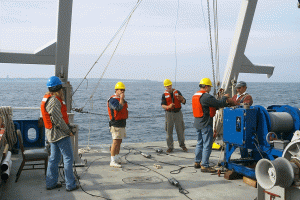
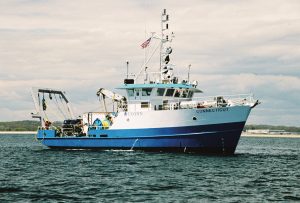
Where Are They Now? One Year After Avery Point
In 2018, seven graduate students from the Department of Marine Sciences completed their degrees, five with master’s and two with doctorates. We checked in a year later to see what they’ve been up to.
Michelle Fogarty landed a postdoctoral researcher position in Marine Energy Resource Characterization at the National Renewable Energy Laboratory in Boulder, Colorado. On the other side of the country, Ellen Johnson is in San Diego, California working as a content writer and science communicator. Check out her blog, currentseablog.com, to read some of her articles about sustainability and the ocean. After completing his undergraduate and master’s studies at UConn, Matthew Lacerra began his doctorate at Princeton University where he is studying paleo-oceanography in Dr. Daniel Sigman’s group. Almariet Palm scored a position as a Project Geologist with HRP Associates Inc in Farmington, Connecticut. Gihong Park conferred his doctorate and continued at Avery Point as a postdoctoral research associate with his PhD advisor, Dr. Hans Dam. Julie Pringle moved back to Martha’s Vineyard, Massachusetts and began working as a Field Science Coordinator for a local non-profit called the Great Pond Foundation. She commented on being back in the field, “after spending the majority of my graduate research in the lab, I’m really enjoying all the field work!” Last but not least, Heidi Yeh started her doctorate studying oyster aquaculture at Rutgers University in New Jersey. She is “employing genetic techniques to promote sustainable seafood production.”
Some recent alumnae/i entered the next step in academia, while others moved into the work force. This just goes to show that a graduate degree from the Department of Marine Sciences can prepare you for a variety of career paths. It will be interesting to see where they wind up next!
Molly James
Getting to know our staff: Bob Dziomba – Machine Shop
After a 13-year stint working on nuclear reactors for the US Navy, Bob has been our marine research technician in the machine shop for 26 years. After Gary Grenier’s retirement in 2017, he now has to manage the workload in the shop himself. Bob simply describes his day-to-day job as “fix and repair,” which is an understatement. Without his skills, the Department of Marine Sciences (DMS) would be at a loss.
As a trained machinist, Bob has contributed to a majority of DMS research projects by helping faculty design, build, and test prototype equipment, while also maintaining and repairing it when it breaks. Earlier during his tenure, Bob also enjoyed servicing the departments’ small submersibles and remotely operated vehicles (ROV), which required particular care due to the nature of high-pressure equipment. Over the years, he helped shape the machine shop into the highly functional facility that it is today.
Major experimental setups like the flow-through system in the Rankin Seawater Lab were constructed with Bob’s input and hard work. Bob also helped building the Larval Fish Rearing System that allows experimental manipulations of water temperature, CO2 and oxygen levels to study potential effects of marine climate change on marine organisms. In Bob’s spare time, he helps other technicians with repairs on our marine vessels and teaching laboratories. Outside the machine shop, Bob’s friends and family value his mechanical skills.
DMS research operations rely on Bob’s expertise to construct prototypes and conserve functional equipment. As a department we fortunate to have such a skilled and caring technician.

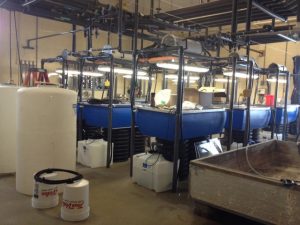
The First Ocean Expedition Course
On October 17-19, 2018, six graduate students from Department of Marine Sciences participated in the first ocean expedition course ever offered by the university. Students have long lobbied for a course that teaches ship-based oceanographic methods, and after much logistical and scientific preparation by faculty, staff, and students, the team set sail aboard the R/V Connecticut. The objective of the cruise was to sample oceanographic data from Long Island Sound outwards to the continental shelf break. The team was led by Professors Jim O’Donnell, Frank Bohlen, Samantha Siedlecki, and Hannes Baumann, with research support from Kay Howard-Strobel and David Cohen. The student participants were Molly James, Jimmy deMayo, Alec Shub, Michael Mathuri, Amin Ilia, and Callie Concannon.
The course was designed to give students a chance to experience data collection aboard a research vessel from all oceanographic disciplines. Students oversaw around-the-clock deployment of CTD/rosette casts, sediment grabs/cores, Methot net trawls, and vertical plankton tows at a total of 7 stations. On board the ship, students analyzed pH and prepared samples for later analysis. Unfortunately, weather conditions limited the trip to just 36 hours instead of the intended 48 hours, but the team still managed to collect the data they intended to analyze. With the help of Dr. Claudia Koerting, students used analytical spectroscopy techniques to measure dissolved oxygen, nutrients, and chlorophyll concentration. After all the data was analyzed, the final cruise report was constructed, and the results were presented the following semester at the weekly Brown Bag seminar series hosted by the Marine Sciences Graduate Students. This course provided students with great hands-on experience and introduced the students to areas of oceanography previously beyond their knowledge levels.
To access all the data that was collected during the expedition, log on to ftp://nopp.dms.uconn.edu/ocean_course.
The graduate student class with faculty
Nighttime sampling station
Jimmy deMayo
